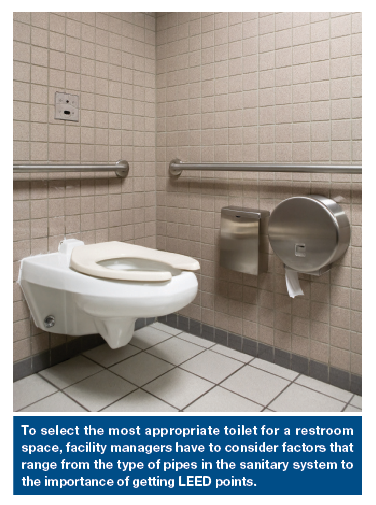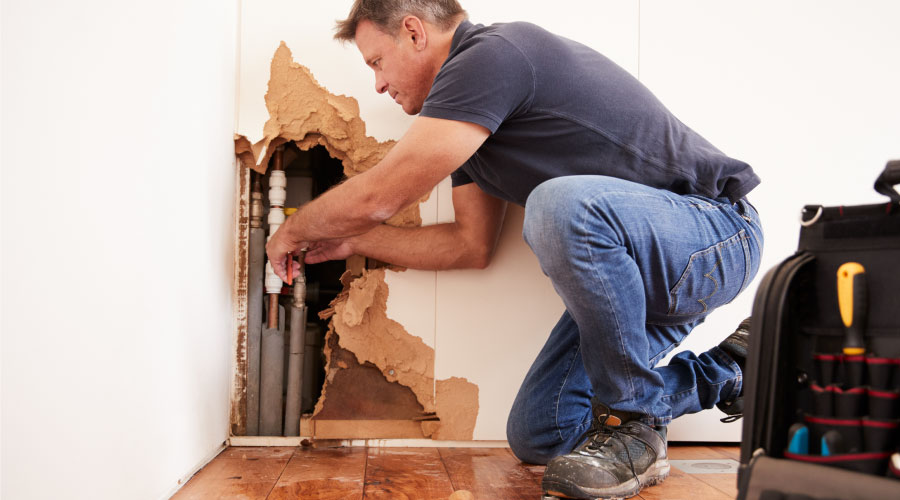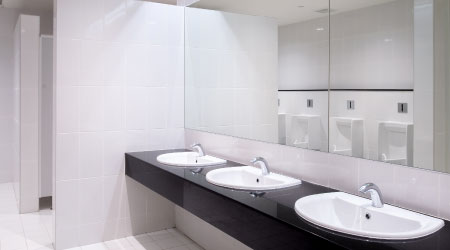Real-World Experiences Help Identify Water-Saving Choices
Water conservation has become the standard in new restroom design — whether it's required by local code, to obtain LEED points, save on operating costs or appeal to environmentally conscious customers. Manufacturers have been responsive and there are a lot of great new products to meet the demand. However, once those products are installed, if facility managers don't do their due diligence on how systems interact and whether particular products are the right fit for their situations, there might be some surprises.
Sometimes this is a problem with perception and not a failure of the fixture to perform as intended. Facility managers, not to mention occupants, are accustomed to toilets, sinks and showers working in a certain way. And when they don't function as expected, facility managers find themselves on the hot seat. But it's also true that some water-saving products work better than others.
In addition, a water-efficient fixture may have been rigorously tested by the manufacturer, only to be applied in a space for which it wasn't intended. For that reason, it is necessary to examine how the design of the restroom as a whole affects fixture performance.
Dual Considerations
For new buildings, perhaps the most common water-saving restroom strategy is to select dual-flush toilets. Dual-flush technology, using either 1.1 or 1.6 gallons-per-flush (gpf) has been around for several years, and dual-flush toilets have always been a pretty successful option for water-conscious facility managers. They're also a good option because they can be retrofitted into existing buildings and used on smaller projects where the occupants are determined to save water.
However, one of the issues with dual-flush toilets is that the handle on a flush valve fixture must be pulled up to achieve the lower flush. The reflex for most people is to push down. This introduces a possible "user error," i.e., how do you know that the right flush is being used for the job? This makes actual water savings more difficult to predict.
Another type of dual-flush system is the dual-flush tank water closet. Dual-flush tank-type fixtures typically have push buttons on top, rather than a lever flush handle on the side, as required to make them ADA compliant.
If facility managers are interested in calculating precisely how much water their fixtures are using, and want to remove the possibility of user errors in their water efficiency goals, another option may be to simply to use low-flow 1.28-gpf water closets.
These days, facility managers also have options for even more water-efficient toilets — 1.1 or 1.0 gpf pressure-assist fixtures, for instance. While these use the least water, they do have a louder flush sound. But because of their low water use, these types of toilets are the best option of facility managers that are interested in maximizing their points in the LEED rating system.
One final note: Using less water may introduce a new problem. If the sanitary system is cast iron, there is a good chance of increased clogging. There just isn't enough water to move the waste through. A higher flow fixture installed upstream can help. Smooth interior piping installed at a minimum 2 percent slope may be required. Obviously, this is something that should be determined early in the design process and may not make using captured rainwater a viable choice for remodels.
Like water closets, low flush options have improved for urinals. But there are still some important things to consider. The 0.125 gpf urinal is a great water-saver, but in some models, such as a stall type, it may be necessary to prove to a local inspector that there is enough water to wash down the fixture, as required by most codes. It may be necessary to check with the manufacturer that its product has been approved for use in a municipality or state. There is also a possibility of buildup of minerals in the trap due to less water dilution of the urine.
Water-free urinals are another options. These have been around for a while, and are increasing in popularity, but are still not accepted by all jurisdictions. In addition, concerns expressed by maintenance staff have kept them from becoming mainstream.
If a building plans to use harvested rainwater (see "Rainwater Supplied Fixtures") for fixture flushing, it may make more sense to use a low-flush fixture (rather than water-free) to reduce potential maintenance issues. That's because the water used to flush the urinals isn't water from the city system, so in essence, the building is still net-zero in terms of its water use for flushing the urinals — and without the potential maintenance issues that come with waterless urinals.

Related Topics:













